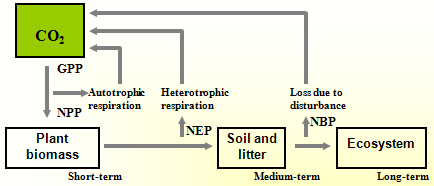(Upload on January 10 2019) [ 日本語 | English ]
Mount Usu / Sarobetsu post-mined peatland
From left: Crater basin in 1986 and 2006. Cottongrass / Daylily
HOME > Lecture catalog / Research summary > Glossary > Growth
Plant growthsize increase by cell division and enlargement, including synthesis of new cellular material and organization of subcellular organellesMeasuring growthfresh weightdry weight volume length height surface area |
[ photosynthesis | productivity | allometry | related to chemistry ] Absolute growth rate, AGR (絶対成長速度)AGR = dY/dt ≈ (Y2 - Y1)/(t2 - t1)
dY: size |
Growth analysisPolynomial regression (Orloci & Kenkel 1987)fw(T) = lnW = a + b1T + b2T2 … (1) where W = the leaf area (LA) or sededling weight for a seed size class
T = the time at which the measurement is taken f'w(T) = dW/dt = b1 + b2T × 2 … (2) here, b1: intercept of relative growth rate
b2: slope of the relative growth rate ∴ Tmax = -b1/(2b2) |

1) Logistic growth= geometric growth or logarithmic growth(Mitscherlich 1909) a) Mitscherlich equation (ミチェーリッヒ式)dY/dt = k(M - x) ⇒ Y = M - (M - x0)e-kt
k: proportionality constant (considered as efficiency coefficient) b) simple logistic equationIssues on allometrySum is not the sumEx. considering two parts of biomass, e.g., stem (w1) and leaf (w2)
If w1 = aDb and w2 = cDd, then w1+2 = w1 + w2 = aDb + cDd |
Productivity (生産力)Gross primary productivity, GPP (総一次生産力)= energy (E) or carbon (C) fixed via photosynthesis per unit time Net primary productivity, NPP (純一時生産力)
= GPP - E or C lost via respiration (by plants) per unit time
ΔB = biomass change in the community between time 1 (t1) and time 2 (t2) = B2 - B1 = NPP - heterotrophic respiration Net biome productivity, NBP (純バイオーム生産力)
= NEP - loss due to disturbances |

|
|
Shape: an object encompasses all of its geometric properties except its size, position and orientation
Morphological integration: The covariation of morphological structures in an organism or of parts in a structure, which may reflect developmental or functional interactions among traits allometry = allo (different) + metric (measure)isometry = iso (same) + metric (measure) relationships between two (growth) parameters → study to define the relationship between size and shape (s.s.) The dependence of shape on size, often characterized by a regression of shape on size y = αxβ ⇒ logy = logα + βlogx → Y = βX + a (linear equation)
β: coefficient of relative growth (相対成長係数) = dY/dX = dlogy/dlogx = (dy/y)/(dx/x) = (x/y)·(dy/dx) t = 0 → α = y0/x0β |
Differentiated by t 1/y·(dy/dt) = β·1/x·(dx/dt) (Huxley 1932)
Ex. Relative daiameter growth rate, RDGR (Harper 1977) D1, D2: diameters at time 1 and 2, respectively Isometry (等成長, アイソメトリー)Geometrically similar objects exhibit what is called isometric scaling; the relationships between surface area, volume, and length≡ β = 1 or integer Ex. the relationships between surface area, volume and length t-test, t = (b – β)/sb, sb = s2·y·x·Σ(X – m)2 (Rensch 1950) Rensch's rule (レンシュの法則)Rule in the relationship between the extent of sexual size dimorphism and which sex is largerAcross species within a lineage, size dimorphism increases with increasing body size when the male is the larger sex, and decreases with increasing average body size when the female is the larger sex |